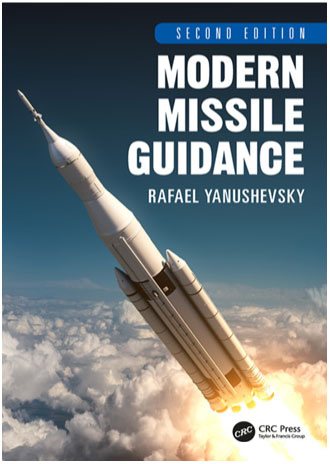
A primary aim of the author is to present missile guidance law design ‘from the point of view of control theory’.
Chapters 1–3 act as an introduction to guidance laws based around Proportional Navigation (PN) and, in particular, includes their analysis by the method of Adjoints. Adjoint analysis provides the sensitivity of miss distance to initial conditions as a function of time-to-go.
The main theme of the book is developed in Chapters 4, 6 and 7. Chapter 4 sets out the basics of frequency domain analysis. Analytical expressions are developed for Laplace transformations of impulse responses arising from Adjoint analysis. From these steady-state characteristics for ‘miss due to target step manoeuvre’ and ‘peak miss due to weave’ as a function of frequency are obtained. Chapter 6 uses these results in order to derive a criterion for reducing peak miss. Similarly, Chapter 7 uses frequency domain analysis to develop expressions for root-mean-square (rms) miss due to various types of seeker noise and rms miss due to target manoeuvres with random starting time.
Chapter 5 (and part of Chapter 2) considers complementary time domain approaches based on optimal control (added for the Second edition) and Lyapunov stability theory. Unfortunately, in the latter case, the issue of asymptotic stability (for what is essentially a time varying fixed end time problem) is rather sidestepped. Appendix A1 is misleading because, in the case of the basic PN dynamics described in Chapter 2, a time transformation of the form t* = −loge (normalised time-to-go) reduces the basic linear time varying dynamics to a linear time invariant form. The cost function used in the section on optimal control is unusual in that it tends to keep sightline rate low throughout flight rather than concentrating on the end conditions. For example, the augmented law for known target step manoeuvre given in Section 5.4 can cause a missile to manoeuvre even in cases where a straight-line interception would be possible (N ≠ 3). Also, no mention is made of optimal compensation for gravity and uncontrolled but known missile longax.
Two new chapters are added for the Second edition: Chapter 8 deals with ‘Guidance of Fixed-Wing UAVs’, and Chapter 11 considers ‘New Generation of Intercept Systems for National Missile Defense’. Chapter 8 concentrates on some of the different objectives that UAV guidance (cf. missile guidance) may have to achieve: waypoint following, rendezvous and obstacle avoidance. What is missing is a discussion of the major physical differences between UAVs and missiles and the consequences for guidance law design. The proposed waypoint scheme is not realistic because any attempt to home directly onto waypoints leads to discontinuities in lateral and roll control that reduces speed and adversely affects on-board sensors. More practically, waypoint information can include position, flight-path direction and curvature.
Chapters 9 and 10 deal briefly with testing guidance laws using simulation and present the author’s views on integrated missile design. The book concludes with a chapter that includes MATLAB® and Fortran programs to implement some of the previously described methods.
Overall, the book is not an alternative to a standard text such as Zarchan’s Tactical and Strategic Missile Guidance (American Institute of Aeronautics and Astronautics, Inc. 2012 – Fifth edition). The lack of any treatment of seeker parasitic errors is a significant omission. However, the sections on an analytical frequency response approach are worth exploring.


